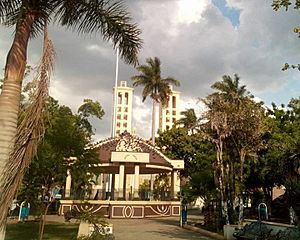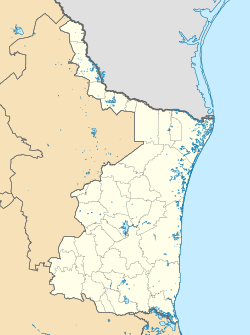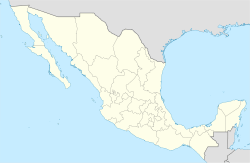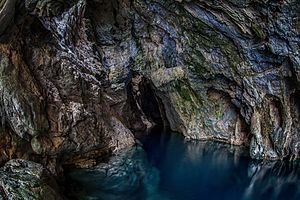Ciudad Mante facts for kids
Quick facts for kids
Mante, Tamaulipas
|
|
|---|---|
| Ciudad Mante | |

Center of Ciudad Mante
|
|
| Country | |
| State | |
| Municipio | |
| Area | |
| • Total | 1,699.98 km2 (656.37 sq mi) |
| Elevation | 80 m (260 ft) |
| Population
(2005)
|
|
| • Total | 112,061 |
| • Density | 65.9/km2 (171/sq mi) |
| Time zone | UTC-6 (CST) |
| • Summer (DST) | UTC-5 (CDT) |
Mante, officially called Ciudad Mante, is a city in the Mexican state of Tamaulipas. It is located in the southern part of Tamaulipas. Mante is the main city of the El Mante area.
In 2005, about 81,884 people lived in the city. This was about 73% of the total population of El Mante municipality. Mante is the ninth-largest city in Tamaulipas by population. The El Mante municipality covers an area of 1,699.98 square kilometers (656.37 sq mi). It includes smaller towns like Celaya and El Limón. The city has its own airport, the Ciudad Mante National Airport.
Mante's official saying is Donde el Azucar es mas Dulce que la Miel. This means "Where sugar is sweeter than honey."
History of Mante: A Look Back in Time
The area we know as Mante today has a name that comes from the ancient Huastecan people. They called it "cinco potreros de Tamatán," which means "five pasture grounds." In their language, "Tenek" or Huastecan, it also meant "the embarkation of canoes."
Long ago, this region was often flooded by rivers. The Mante River's waters would stay for months, creating large lime deposits. This made it a difficult place to live because of many mosquitoes and horse-flies. Their bites were very painful. Because of these tough conditions, Spanish settlers could not stay here permanently. However, the land was very rich and fertile, so they did farm in the area.
Early Inhabitants and Challenges
Studies show that several groups of "collector-hunters" lived here. The Parnes, Chichimecas, and Janambres were the main tribes. The Janambres were known to be very protective of their land. They would attack anyone who tried to settle in the "Tamatán" area. Stories say they were always hostile to new settlers. When fights happened, the Janambres would retreat to the hills.
Early in the Spanish conquest of Mexico, some Augustinian missionaries visited the Mante region. They traveled to areas like Tamezin and Tanguachin. However, there is no clear proof that these missionaries started any permanent missions or colonies here. So, the area, also known as "The Luxuriant Embarkation of Canoes," was not officially settled by the first Spanish leaders.
How Mante Began to Grow
The land in a nearby settlement, San Juan Bautista de Horcasitas, was not very good for farming. Because of this, some settlers moved towards the Tanchipa mountains. They found fertile lands near the Mante River spring. Here, they grew corn, beans, sugar cane, and fruits. These crops helped them live and trade.
In November 1750, a leader named Escandón visited Horcasitas. He saw that the Mante area was already populated. He decided to give these lands to the Bishop of Manila, Don Manuel Antonio Rojo de la Fuente and Vieyra.
After all the legal steps, Escandón ordered Captain Juan Antonio de Barberena to take official possession of the lands. This happened on March 8, 1764. At that time, a count was made of the settlers and the native Huastecan and Olive Indians living there. Thirty-five settlers lived near the Mante River spring. Sixty-six more lived in the area from Abra to Tanchipa.
Some people see this date and these settlers as the founders of the area. It was first called "The Luxuriant Embarkation of Canoes." Later, it became "Rancho Canoas" (Canoe Ranch), then Villa Juárez, and now Ciudad Mante. However, simply dividing land among people does not mean a town is officially founded. So, Ciudad Mante does not have one exact founding date.
What Does the Name "Mante" Mean?
There are two main ideas about where the name "Mante" comes from.
One idea, from a local researcher, says "mante" comes from the Nahuatl language. He suggests it means "the place of the water in the rock" or "where the water comes out of the rock." This would refer to the Mante River spring, which flows from rocks in the "Sierra de Cucharas." However, Nahuatl-speaking tribes never lived in this region. The local tribes were Huastecan, who spoke "tének."
The second idea, supported by educators who study the Tének language, says "mante" is a Tének word. It comes from "man" meaning "yellow" and "te" meaning "stick" or "tree." So, "mante" refers to a specific tree. When its fruit ripens, it turns a very bright yellow. This makes the tree's leaves look yellow from a distance.
This "mante" tree gave its name to the Mante River. Later, the sugar mill and the city of Mante also got their names from this tree. If the first idea were true, only the river would be named Mante, not the tree. Based on this, the name "Mante" likely comes from the "yellow stick (or tree)" of the sapota family.
Fun Places to Visit in Mante
Mante has many interesting places for visitors. Some are right in the city, and others are nearby.
La Difusora: A Cool Swimming Spot
"La difusora" is a large irrigation channel. For the past 20 years, it has been a popular swimming area for locals. Its name comes from an old radio station that used to be nearby. "La difusora" recently received a big investment to make it safer. You can find local food vendors selling snacks there in the afternoons.
El Nacimiento: The Birthplace of Water
"El Nacimiento," or "The Birthplace," is just 7 miles from the city on a gravel road. You can visit it any time of year. It's an amazing spring where water flows out of the rocks in the "sierra de Cucharas" (Spoon Ridge Mountains). It's a great spot for families to have a picnic and enjoy nature. You can swim or take a relaxing boat ride. If you swim to the mouth of the cave, you can see light entering the cave above the clear, emerald-tinted water.
La Aguja: The Needle and the Dam
"La Aguja," meaning "The Needle," is another swimming spot about 4 miles from Mante. It was created when a dam was built on the Mante River. This dam helps water the large sugar cane farms in the area. The dam was built between 1927 and 1929 and opened on August 9, 1929. From here, you can travel upstream by boat all the way to "El Nacimiento."
Beaches of Limon: Where Rivers Meet
The Beaches of Limon are about 7.5 miles north of Mante. This area is close to the town of Limon. Here, the Sabinas and Frio (Cold River) rivers join together and flow into the Guayalejo River. Many tourists visit this beautiful spot.
Exploring Caves: El Abra and Quintero
The cave at "El Abra" and the natural cave of Quintero are two caverns in the Cuchara Sierra. They are popular because they are close to Ciudad Mante. Inside the El Abra cave, there is a "basement" section 380 feet from the entrance. Cave explorers from San Antonio, Texas, partly explored it in 1956. The Quintero cave is home to thousands of bats. They fly out of the cave at dusk to find food nearby.
El Castillo De Nueva Apolonia: A Ruined Castle
"El Castillo De Nueva Apolonia" is a castle-like building. It was built a long time ago and was part of a large farm called "El Naranjo" (The Orange Tree). It was very famous in its time and even hosted important guests like General Porfirio Diaz. It is located south of the village of Nueva Apolonia. Today, the castle is in ruins. Many of its original features, like a grand piano and bathtubs, are gone. The staircase to the top floor is unstable. Next to the castle is a small chapel with stone graves. The castle is very worn down, with plants growing inside. Most of its tiles are gone, but you can still see some of the original paint on the walls. The castle stands as a reminder of the old El Naranjo farm, with its original coat of arms still in the lobby. It is slowly falling apart.
El Cielo: A Natural Paradise
"El Cielo" means "The Heaven." It is a protected cloud forest that covers a huge area of 144,530 hectares (about 357,129 acres). It is a true paradise for many different animal species. You can find 175 types of migratory birds and 225 local birds here. There are also many amphibians and mammals, including white-tailed deer, jaguars, and black bears. This amazing variety of life is due to the special climate, biology, and landscape of El Cielo.
See also
 In Spanish: Ciudad Mante para niños
In Spanish: Ciudad Mante para niños




